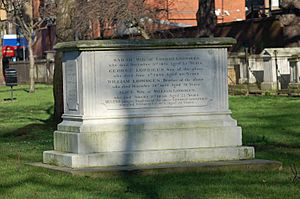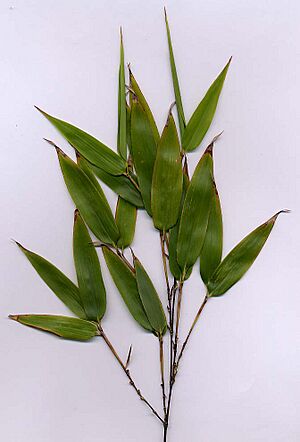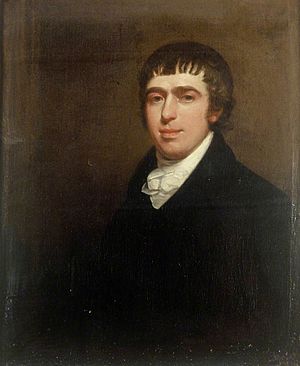Loddiges family facts for kids
The Loddiges family ran a very famous plant nursery in the 1700s and 1800s. They were known for bringing new and exciting plants, trees, shrubs, ferns, palms, and orchids to gardens all over Europe.
Contents
How the Loddiges Nursery Started
The person who started the nursery was Joachim Conrad Loddiges (1738–1826). He was born in Hildesheim, Lower Saxony, which is in Germany. His father was a gardener.
Conrad trained in the Netherlands. When he was 19, he moved to Britain during the Seven Years' War. He became a gardener for Dr. J. B. Silvester in Hackney, a village near London. This is when his family name became more English.
When Conrad was in his forties, he bought a small seed business. It belonged to another German, John Busch. Conrad paid for it fully by 1777. Then, he started writing to people all over the world. He asked them to send him seeds from different places.
From these small beginnings, the nursery grew. Its first catalog came out in 1777. The business became very popular in Britain. Soon, it attracted customers from large estates and botanical gardens across Europe.
Growing the Business with Joachim Conrad
On January 2, 1770, after he got married, Joachim Conrad Loddiges asked his boss, Dr. Silvester, for advice. He wanted to leave his job as head gardener. He planned to start a small seed and gardening business in Hackney.
He got help from John Busch, another German who had moved to England. Busch later became the chief gardener for Catherine the Great in Russia. Conrad and Busch stayed in touch. Because of this, the Loddiges family helped bring rhubarb to Britain. They received seeds from famous plant explorers like John Bartram and William Bartram from North America. They also got seeds from regular travelers.
One of the first plants Conrad Loddiges brought to Britain was the Common Mauve Rhododendron, called Rhododendron ponticum. He introduced it in the early 1760s. This was when he worked for Dr. Silvester. He supplied young plants to the Marquis of Rockingham. This made many people excited to grow this plant in British gardens.
George Loddiges and the Nursery's Fame
The nursery became very famous in the early 1800s under George Loddiges (1786–1846). He was Conrad's son.
From 1818 to 1833, Conrad and Sons published 20 issues of The Botanical Cabinet. This was a magazine with over 1000 colored pictures of rare plants. These plants were brought from around the world to the nursery's gardens.
The nursery built the largest hothouses in the world. They showed off the best collection of palms and orchids in Europe. George Loddiges also connected the nursery to important scientists. He became a member of several scientific groups in London. He was interested in many science topics, not just plants. He knew a lot about early microscopy and humming-birds.
The nursery's influence spread far. It reached the royal gardens in St. Petersburg, Russia. It also helped start the first Botanical Gardens in Adelaide, South Australia, in 1839.
Even though the business closed in the 1850s, it left an important mark. Many beautiful plants we see today were first brought into gardens by Loddiges Nursery.
George Loddiges' Contributions
Conrad's son, George Loddiges, is often given credit for making the Hackney nursery even more famous. In 1833, the Loddiges family started using the new Wardian Case. This was a special sealed glass box used to transport live plants. They used it to bring plants from Australia. George was also very interested in microscopy and hummingbirds. One hummingbird, the Marvelous Spatuletail, was named after him.
For example, the word 'arboretum' was first used in an English book by J. C. Loudon in 1833. He wrote about George Loddiges' famous Hackney Botanic Garden arboretum. This arboretum started in 1816. It was open for free to the public every Sunday for education. Loudon wrote that it was "the most interesting" garden scene near London.
A map of George Loddiges' arboretum was in The Encyclopaedia of Gardening in 1834. This map helped inspire Loudon to write his big book, Arboretum et Fruticetum Britannicum. This book was first published in 1838. It used many drawings from George Loddiges' well-labeled arboretum.
Another famous visitor was Charles Darwin. In September 1838, he wrote about seeing "1279 varieties of roses!!!" at Loddiges' garden. He saw this as proof of how much plants can change.
George Loddiges' arboretum was praised, but his tropical hothouses were even more famous. He built the world's largest hothouse at his Hackney nursery. He also invented a system of warm, mist-like rain. This helped keep tropical palms, orchids, ferns, and camellias in perfect conditions. It was almost like a 'tropical rainforest'.
George Loddiges' hothouses used new inventions. These included curved iron glass bars and central heating systems. With his own ideas, these allowed many new tropical plants to grow. Some even flowered for the first time in Europe.
In 1822, visitors saw the camellias blooming. They noted that the hothouses were amazing. One was forty feet high, with a banana tree almost reaching the top. A few years later, in 1829, a visitor from Germany named Jacob Rinz was amazed. He said he felt like he was in Brazil. He especially loved it when Mr. Loddiges made "a shower of artificial rain." These conditions were perfect for tropical orchids. Several orchids were named after George Loddiges, like Loddiges' dendrobium.
George Loddiges and other nursery owners made people very interested in new plants. So, he started selling books with colored pictures of the new plants. This series was called The Botanical Cabinet. It had twenty volumes and 2,000 pictures. George Loddiges added a short text next to each plant picture. Many of the drawings were made by George himself, his daughter Jane, and young Edward William Cooke. Edward Cooke later became a famous artist.
The Horticultural Society gave George Loddiges many medals:
- Silver Medal, 1818, 1819
- Silver Medal (Sir Joseph Banks Memorial Portrait Prize), 1823, 1826, 1832, 1835
- President's Silver Medal, 1836
- Silver Flora Medal, 1837
In the late 1830s, George Loddiges helped design Abney Park Cemetery. This was one of the "Magnificent Seven" London cemeteries. He carefully kept the old parkland from the 1700s. He added an educational landscape around the edges. This area was open to the public for free. It was a huge arboretum with 2,500 types of trees and plants. They were labeled alphabetically.
Near the Abney Park Chapel, he also created a rosarium (a rose garden). This matched the chapel's 'botanical rose windows'. These windows had an unusual ten-part design, like the five petals and five sepals of the rose family. George Loddiges also seemed to influence the design of the main entrance. It had an Egyptian style with pictures of the Egyptian White Lily or Lotus. This plant was brought to Western gardens by Loddiges Nursery in 1802.
In May 1838, John James Audubon published the last volume of his "Ornithological Biography." This book went with his famous "Birds of America" series of 435 pictures. Audubon wrote about the "Anna Humming Bird." He said he made the male bird pictures from specimens given to him by Mr. Loddiges of London. He said Loddiges' collection of hummingbirds was "unrivaled."
The Nursery Closes

When George Loddiges died in 1846, his son Conrad Loddiges II (1821–1865) took over the nursery. It became harder to keep the business going. The land owner, St. Thomas' Hospital, wanted much higher prices for the land. London was growing, and the land was now valuable for building houses. The part of the nursery that the Loddiges family owned was also becoming more valuable for building. It was losing its quiet countryside feel.
Conrad Loddiges II helped display ferns and terrariums for the Great Exhibition. The nursery slowly closed between 1852 and 1854. This was because the lease from St. Thomas' Hospital ended. Conrad Loddiges II offered all the exotic plants to Kew Gardens for £9,000. But Kew Gardens refused. (Twenty years earlier, the collection was worth £200,000!)
Many rare plants were sold at auctions. This included rare orchids bought by John Day, who became a famous plant artist. Joseph Paxton bought 300 palms and plants for the new Crystal Palace in Sydenham. The Illustrated London News showed pictures of horses pulling a giant palm tree through London. It was on its way to be shown by Paxton for the opening of the Crystal Palace by Queen Victoria.
Where to Remember the Loddiges Family
Today, you can see memorials to the Loddiges family. They are in the gardens of the Church of St John-at-Hackney and Abney Park Cemetery.



